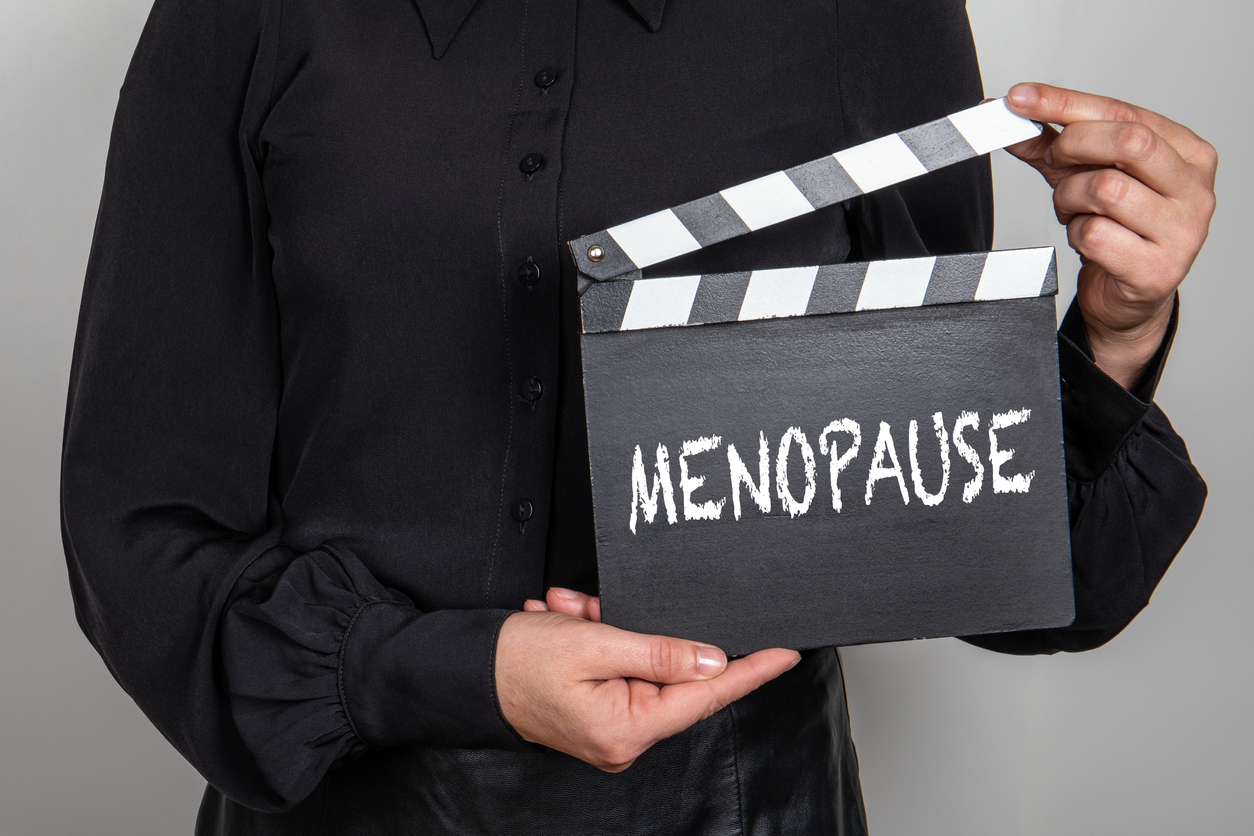As part of Menopause Awareness Month we wanted to talk about helping to manage the menopause. Also, during October you can save 20% on all of our menopause courses by using the code MENOOCT.
Mood swings. Weight gain. Waking up to sweat-soaked pyjamas and bedsheets. Your body suddenly doing a lot of stuff you don’t recognise. Menopause can be a weird, uncomfortable and downright scary time for many. Dr Linia Patel explains how good nutrition can help cope with the menopause.
Understanding what’s changing during menopause, why it’s happening, how to deal with it and what food to eat can make the whole process a lot less confusing and frustrating.
What is menopause?
Think back to puberty. The whole process took quite a few years and so do the changes related to the menopause. The transition to menopause usually involves a transition through perimenopause first. Typically, perimenopause begins in a clients’s 40s and the menopause can happen any time between a their 40s and 60s. Officially, menopause occurs when they haven’t had a period for 12 months in a row. In the UK, the average age for this to happen is 51 years1,2.
What is happening to your hormones?
Naturally with ageing, our hormonal profile changes. As the menopause nears, the ovaries decrease the production of two main female sex hormones, oestrogen and progesterone.
As ovarian hormone production declines, sex hormones are secreted by body fat and other organs such as the adrenal glands; however, overall levels of these hormones are much lower1,2,3. With this decrease in hormonal levels, changes to the menstrual cycle (period) begin to happen. Firstly, it can become irregular and then it eventually stops. Many people go through this change feeling fine, both physically and psychologically; however, some people experience many physical changes that also happen as their body adapts to different levels of hormones. Some of the symptoms include the following1,2,3:
- Hot flushes and night sweats
- Cardiovascular disease
- Osteoporosis
- Mood swings
- Vaginal dryness/infections
- Incontinence/urinary tract infections
- Decline in sex drive
- Insomnia
How to deal with menopause
Menopause is a naturally occurring event and many do not require any treatment at all; however, some people may need more support2. Your GP or menopause specialist can treat menopausal symptoms with hormone replacement therapy (HRT). These hormones can be administered by pills, creams, skin patches, skin gels or implants. A talking therapy such as cognitive behavioural therapy (CBT) can be used to help dealing with low mood and anxiety. Eating a healthy and balanced diet and exercising regularly can also improve some menopausal symptoms. The key when going through the menopause is to not go it alone. Ask for help. Build a strong support network that includes healthcare experts, counsellors, other people going through the same journey, family and friends1,2,3,4.
Which foods in particular play a role?
While all the interactions of our reproductive system are far too complex to predict, one thing is clear: the hormonal phenomena and experience of the menopause is strongly affected by other factors such as stress levels, level of activity, alcohol intake and dietary intake3.
Early research looking into the role of nutrition in the menopause was from observations made when looking at dietary patterns of Asian women in comparison to Western women and the correlation with the incidence of hot flushes. In one study, it was found that only 25% of Japanese women experience hot flushes versus 85% of North American women. Although there are probably many factors involved, such as genetics, other dietary factors such as fish consumption or the difference in the consumption of soy are also thought to play a role5.Soy contains plant-based oestrogens called phytoestrogens and, in the case of soya particularly, isoflavones. Phytoestrogens are very similar to human oestrogen, which means they can have oestrogen-like effects5,6. Dietary surveys show that women in the west consume less than 3mg of isoflavones per day, while women in Eastern Asia consume between 20 and 80mg/day5,6.
More recent studies show that an intake of 50-100mg/day of isoflavones from food could relieve hot flushes by 20.6% and severity by 26.2%. However, it’s worth knowing the following5,6,7:
- Consuming plant oestrogens several times a day appears to be more effective compared to one larger dose.
- It can take two or three months for benefits of plant oestrogens to be seen.
- They seem to work better for some women than others, which may be down to differences in gut bacteria.
- It’s best to get isoflavones from food rather than supplements. Isoflavone supplements might interfere with thyroid function and inhibit mineral absorption, so stick with whole food sources.
- Not all soya foods contain isoflavones. Processing removes 80-90% of isoflavones (i.e., isolated soya protein).
50mg of isoflavones equates to:
- 200g of tofu
- 100-150g tempeh
- 2 cups of soya milk
There are other kinds of phytoestrogens worth including in your diet7,8,9:
| Type of phytoestrogen | Food sources |
| Isoflavones | Soya, chickpeas, lentils |
| Lignans | Flaxseed, sesame seeds, wholegrains, broccoli and carrots |
| Coumestans | Sprouted mung, alfafa beans |
The five menopause foundations to good nutrition
- Tap into plant power7,8,9,10. Experts all over the world agree that perimenopausal and menopausal people should eat more vegetables and fruits, wholegrains, beans and pulses, as well as nuts and seeds. There are many reasons for that. Firstly, there is strong research showing that areas where women consume more plants, less animal protein and less saturated fat have fewer and less intense perimenopausal symptoms, including hot flushes and weight gain. Plant-based foods are also high in fibre, which is key for your gut bacteria. The microbiome is a key lever in the body’s oestrogen levels. Certain bacteria that produce an enzyme called beta-glucuronidase can either increase or decrease oestrogen levels. Higher oestrogen levels mean a later onset of menopause but also lower levels of diabetes and common cancers like breast or endometrial cancer. One of the most effective ways to support the gut bacteria is by consuming more fibre. Recommendations are that you have 30g of fibre per day; however, clinical practice shows me that those who are perimenopausal should be aiming for about 35-50g of fibre per day to promote the good bacteria in your gut and cut back on the bloat.
- Focus on balance2,4,7. With fluctuating hormones, balance is the name of the game. Particularly balance of your blood sugar levels. At the centre of good nutritional habits to help people manage their weight, stabilise mood and control hot flushes is the need to have good blood glucose control. We need a certain amount of glucose/sugar in the blood at all times but having too much or too little in the blood is stressful to the body. Stress can also cause your blood sugar levels to become more unbalanced, so the food choices you make can have a big impact. Refined sugar for starters (think biscuits, cakes, many breakfast cereals, white pasta, white rice and alcohol) are not good for blood glucose levels as they create a blood sugar rollercoaster. Foods with a low glycaemic index (such as wholegrains) when digested release sugar into the blood system slower. Protein is also broken down slowly, which means it releases its energy slowly and, when eaten with carbohydrate, it also slows carbohydrate absorption. Eating protein with each meal or snack will therefore sustain you longer by reducing fluctuations in your blood sugar levels.
- Don’t cut out carbs. Eat the right ones2,4,7,9. Wholegrains, beans and lentils are a great carbohydrate choice during menopause. Why? They contain fibre and protein, which means they are good for your blood sugar levels. In addition, they contain some phytoestrogens. If eaten regularly and in sufficient quantities, they can start to have oestrogen-like effects which is useful as oestrogen levels decline. Legumes are also rich in B-vitamins including folate and B6, which serve as cofactors for enzymes involved with oestrogen metabolism. They also contain zinc, which can help to prevent dry skin, a common complaint of women in perimenopause.
- Flaxseed on everything9,10,11. Lignans are naturally occurring in plant foods like fruit and vegetables, wholegrains, nuts and seeds. However, the lignan content of flaxseeds is almost 100 times higher than any other food. The lignans are concentrated in the outer shell of the flaxseeds; grinding them, therefore, enables you to absorb the lignans better. Research shows that 40g of flaxseed a day may alleviate hot flushes for some women and has a positive impact on vaginal atrophy for other women. It’s also been linked to positive cardiovascular health.
- Speak to an expert. Every person’s experience is unique. If you want to optimally manage your symptoms and are considering supplementation, then it is recommended that you seek help from a dietitian or registered dietitian who specialises in hormone health.
Have you signed up to the Nutrition in Menopause short course online? You can save 20% by using the code MENOOCT in October 2022.
The Nutrition in Menopause course is the cumulation of the latest research and over 15 years of clinical experience working in women’s health. The course is designed for trainers who work with perimenopausal, menopausal or post-menopausal clients or for people who are on their own health journey and who are interested in using science-based strategies to help them continue to perform and live their best lives.
You will:
- learn the different stages of the menopause
- understand the hormones involved and the associated symptoms
- discover effective lifestyle strategies for managing each stage of the menopause and the symptoms that come with it
- gain insight into how to critically appraise supplements in the context of menopause management.
Author bio:

Dr Linia Patel has a BSc degree in biochemistry and physiology and has recently achieved a PhD in public health. Linia is a leading dietitian and sports nutritionist. Her passion is translating nutritional science into easy-to-digest and practical advice
References
-
- National Center for Complementary and Alternative Medicine (2019), Menopausal Symptoms and Complementary Health Practices [online], available from https://nccih.nih.gov/health/menopause/menopausesymptoms, accessed on 17 June 2021.
- National Institute for Health and Clinical Excellence (2015), Menopause: diagnosis and management (NG23), plus (2017) Menopause (QS143).
- Moslehi N et al (2017), Current evidence on association of nutritional factors with ovarian reserve and timing of menopause: a systematic review, Adv Nutr., 597-612.
- Johnson et al (2019), Complementary and alternative medicine for menopause, J Evid Based Integr Med.
- Hazel A (2019), Hot flashes. A review of the literature on alternative and complementary treatment approaches, J Evid Based Integr. Med., 24: 2515690.
- Bedell S, Nachtigall M, Naftolin F (2014), The pros and cons of plant estrogens for menopause, J Steroid Biochem Mol Biol., 139: 225-36. doi: 10.1016/j.jsbmb.2012.12.004
- British Dietetic Association, Menopause Food Facts.
- Franco OH et al (2016), Use of plant-based therapies and menopausal symptoms: a systematic review and meta-analysis, JAMA 315: 2554-2563, Crawford AL et al (2013), The impact of dose, frequency of administration, and equal production on efficacy of isoflavones for menopausal hot flashes: a pilot randomized trial, Menopause, 20: 911-921.
- Chen M et al (2015), Efficacy of phytoestrogens for menopausal symptoms: a meta-analysis and systematic review, Climacteric, 18(2): 260-9.
- Parikh M (2019), Dietary flaxseed as a strategy for improving human health, Nutrients, 25; 11(5): 1,171.
- Meng Q et al (2021), The gut microbiota during the progression of atherosclerosis in the perimenopausal period shoes specific compositional changes and significant correlations with circulating lipid metabolites, 13 (1-27).







